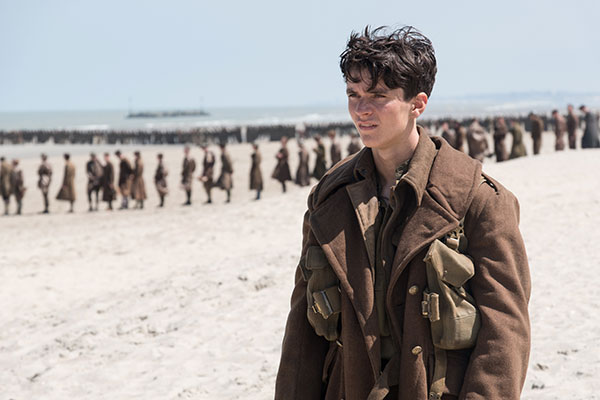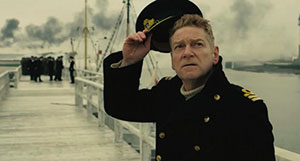Dunkirk
Published in 20th-century / Contemporary History, Issue 5 (September/October 2017), Reviews, Volume 25Directed by Christopher Nolan
By Lar Joye
Christopher Nolan has reimagined the World War II movie for a younger generation and, like Saving Private Ryan twenty years ago, has set a new standard for the war film. If you grew up in the 1970s and 1980s in Dublin, every Sunday there were wall-to-wall British war films on various TV channels. Now, however, western Europe has given up its large conscript armies and cut its military budgets, and the modern film audience has no knowledge of war or how armies work. The movie deals with this by focusing on the soldiers and civilians involved—their confused experiences, their developing panic and finally their fight for survival.
In Operation Dynamo, 338,226 French, Belgian, Dutch and British soldiers were evacuated from Dunkirk between 26 May and 4 June 1940. The film ranges back and forth across its three strands—the ‘mole’, the air and the sea. First, it focuses on Commander Bolton of the Royal Navy (played by Kenneth Branagh), organising the rescue from the mole or pier in Dunkirk Harbour. The focus then shifts to a Spitfire pilot (played by Tom Hardy), as he endeavours to protect the ships and soldiers on the beaches, while three soldiers (played by Fionn Whitehead, Harry Styles and Aneurin Barard) try to get off the beaches. The final story involves a boat skippered by Mark Rylance and crewed by Barry Keoghan—one of the gutsy civilian boats that sailed from England to help in the rescue. On the way they save Cillian Murphy, playing a shell-shocked soldier, from the sea, the only survivor of a ship sunk by a German U-boat. There is no explanation of what is happening at a strategic level, and the traditional cut to German generals is not used; indeed, you do not see the enemy up close at all, and overall there is very little dialogue. The film does not rely on modern computer-generated imagery (CGI) but uses real planes and boats, even landing a 75-year-old Spitfire on the beach in Dunkirk in front of thousands of extras.

Above: Fionn Whitehead, who plays one of three British soldiers trying to get off the beaches.
The fall of France in the summer of 1940 left twenty years of British defence plans in ruins, as its army escaped but left most of its equipment behind, including 68,879 vehicles and 20,548 motorbikes; only 23 tanks were brought home. Their strategy was based on the First World War, whereby the small British Army—reduced from seven million men (56 divisions) to 500,000 (ten divisions)—would fight with the French Army, halt the Germans and then get bogged down in trench warfare. The German Army, however, using new tactics called blitzkrieg (‘lightning war’), quickly won a series of battles; the French Army collapsed and the decision to evacuate was made by the Anglo-Irish Field Marshall Viscount Gort.
In many ways the British Army encountered the German Army at its peak in 1940. When it next met the Germans in the summer of 1944, after the D-Day landings of 6 June, it was a different army altogether. Unlike the First World War, where most of the fighting was in the west, this war was really fought on the Eastern Front against the USSR, from the summer of 1941 to May 1945. Both those armies suffered terrible casualties that were not experienced in the west.

Above: Anxious ‘Tommies’ await evacuation at the ‘mole’ (pier) in Dunkirk Harbour.
‘… many soldiers thought they were heroes and the civilian public thought so too. It was not understood that the British Army had suffered a crushing defeat at Dunkirk and that our island home was in great danger.’
The miracle was that the weather remained calm (which is not portrayed in the film), which allowed the Royal Navy to take so many soldiers back to England. The great myth in the film is the role of the civilian ships. While these small boats played an important role in ferrying soldiers from the beach to the larger ships, the majority of the soldiers (239,555) were evacuated from Dunkirk Harbour by 56 naval destroyers.

Above: Commander Bolton of the Royal Navy, played by Kenneth Branagh.
In the last ten minutes the film starts to feel like one of those old war movies, as these complicated historical facts are brushed aside for the arrival of the civilian boats and the reading out from a newspaper of the words of Prime Minister Winston Churchill’s famous speech—‘We shall fight them on the beaches’, etc. But while these words are remembered, the rest of the speech should also be read; Churchill warned that ‘wars are not won by evacuations’ and that ‘we must be careful not to assign to this deliverance the attribute of victory’. Nonetheless, go and see this film, preferably in 70mm or on IMAX, and see the real stars of the show—the Spitfires!
Lar Joye is curator of military history at the National Museum of Ireland (Decorative Arts and History).
















